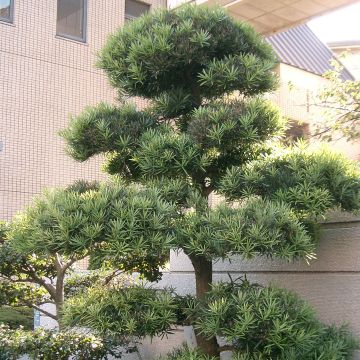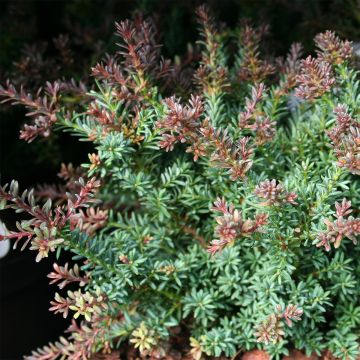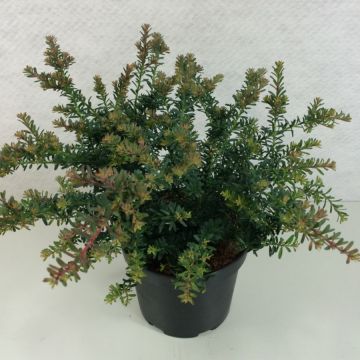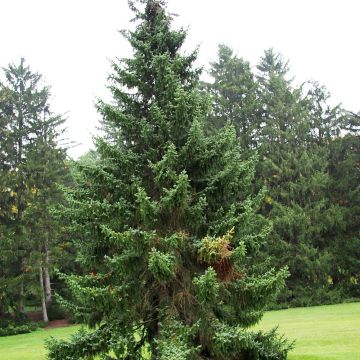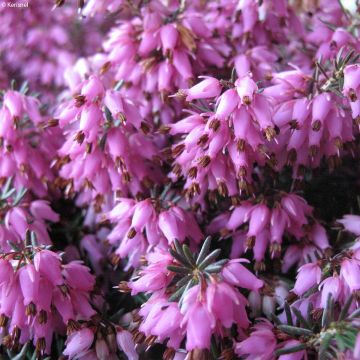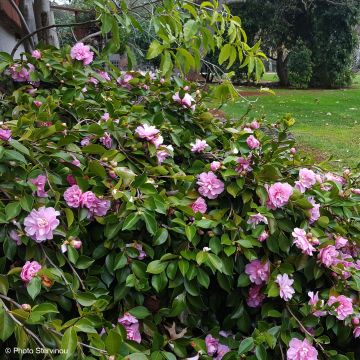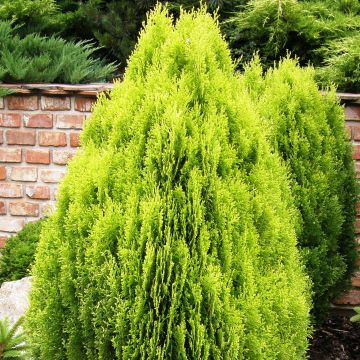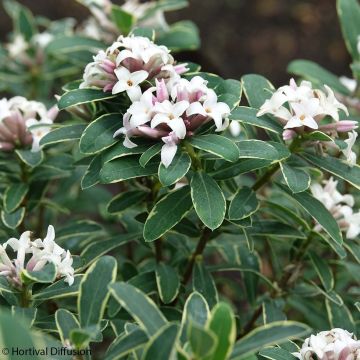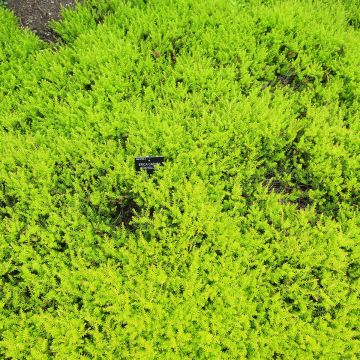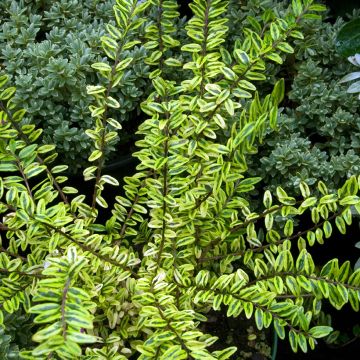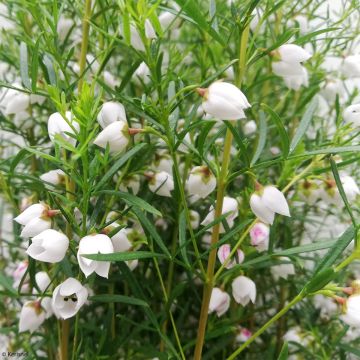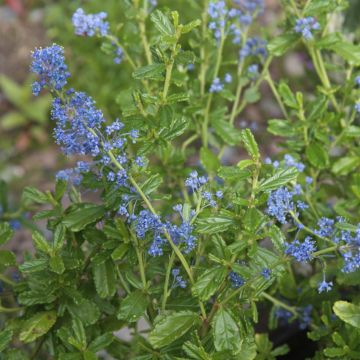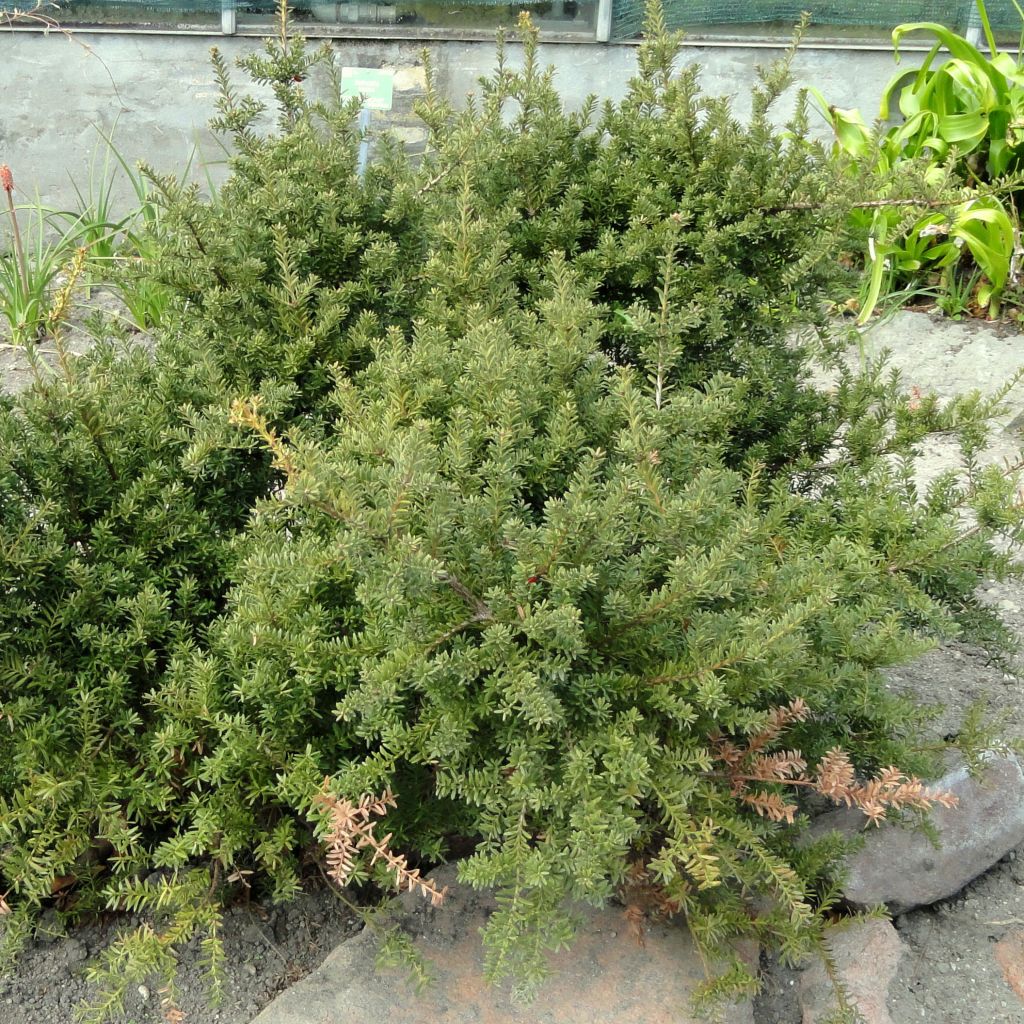

Podocarpus nivalis - Podocarpus des neiges
Podocarpus nivalis
Podocarpus nivalis
Mountain totara, Alpine totara, Snowy Podocarpus
Why not try an alternative variety in stock?
View all →This plant carries a 24 months recovery warranty
More information
We guarantee the quality of our plants for a full growing cycle, and will replace at our expense any plant that fails to recover under normal climatic and planting conditions.
From €5.90 for pickup delivery and €6.90 for home delivery
Express home delivery from €8.90.
Does this plant fit my garden?
Set up your Plantfit profile →
Description
Extraordinarily adaptable, this Podocarpus nivalis descended from the New Zealand mountains, is one of the hardiest in its genus. This little evergreen shrub, which is underutilized in our gardens, forms a somewhat bushy, overall dark olive green, dense and fluffy mass, with a spreading or bushy habit. It thrives in dense shade as well as in the sun, is not very demanding in terms of soil type, and tolerates summer drought once well established, although it appreciates water for its development. Its small size allows it to fit into small gardens or gracefully cascade from the top of a rockery. Definitely worth a try!
Podocarpus nivalis is an evergreen conifer in the Podocarpaceae family, native to the scrubby and subalpine areas of the New Zealand mountains. In its natural environment, and depending on its habitat, it can reach up to 5 m (16ft) in height under favourable conditions, while in lowland areas, in our gardens, it rarely exceeds 2 m (7ft) in height after many years. It will eventually form a dense shrub which is a little wider than tall. Its low, ascending branches bear twigs covered with small, oblong, leathery, olive green leaves with a glaucous sheen. They are grouped in fours and emerge above the numerous branches. The plant sporadically produces some pale yellow male cones and a few female cones that turn red at maturity.
This little-known or forgotten shrub will find its place in a small garden as a group or ideally in a rockery. Its natural appearance, which rivals that of the indestructible Microbiota decussata, blends well in slightly wild gardens, alongside taller flowering shrubs, which it will conceal at the base. It works wonders planted as a small, informal hedge which can also be methodically pruned. In dense shade or in the sun, it pairs well with large stones, geometric lines, and architectural structures. It can be combined with grasses or bamboo to create a more refined ambiance. The true geometric qualities of conifers naturally impose themselves in the design of a contemporary garden, which prefers the aesthetics of shapes, silhouettes, and textures over many different flowers. These structural plants can enhance a bed, mark pathways, decorate patios or balconies, happily substituting trimmed boxwood or holly. The key is to play with volumes and colours.
Idea for colour combinations:
- Complementary shades: gold, burgundy, purple, variegated foliage.
- Matching shades: silver, dark green, blue.
Report an error about the product description
Podocarpus nivalis in pictures
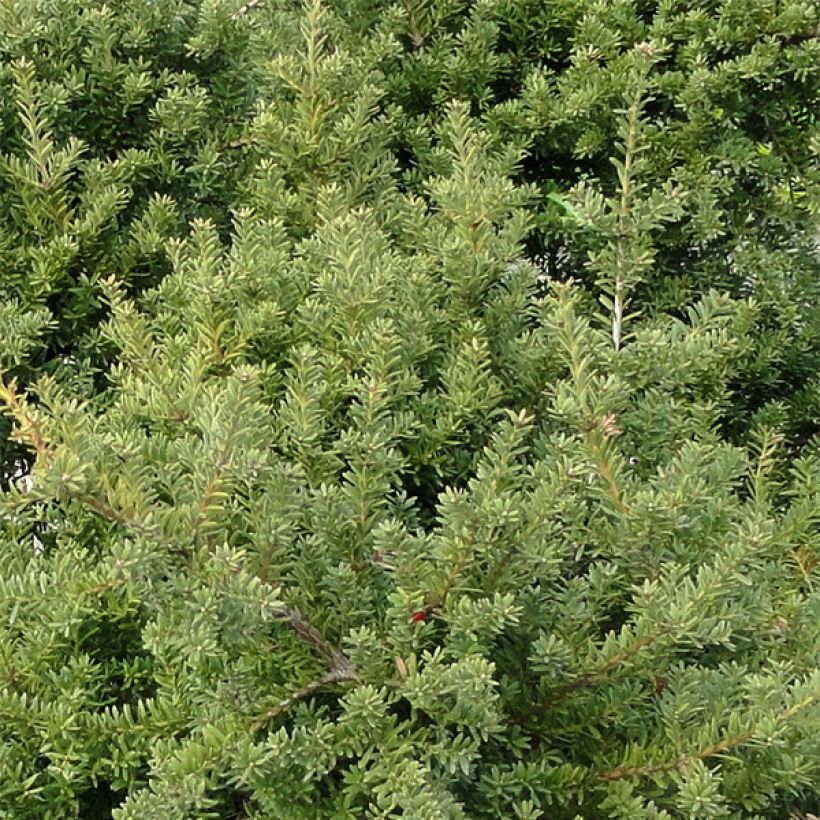

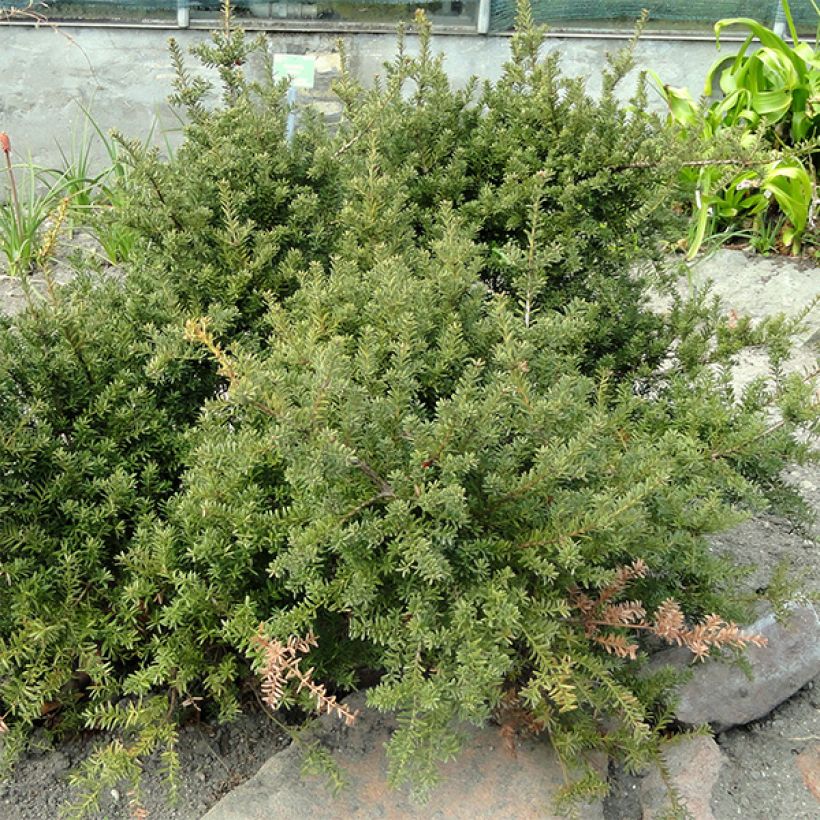

Plant habit
Flowering
Foliage
Botanical data
Podocarpus
nivalis
Podocarpaceae
Mountain totara, Alpine totara, Snowy Podocarpus
Oceania
Other Podocarpus
Planting and care
The Snowy Podocarpus can be planted from September to November and from February to June in well-drained, moist, not too dry, even poor, neutral to slightly acidic, or even limestone soil. It dislikes heavy, waterlogged, or very dry soil in summer and scorching temperatures. Its position doesn't matter too much, it adapts to dense shade, partial shade, or full sun. Soak the root balls well before planting. Optionally add organic matter at planting and water generously for the first two or three years, and during prolonged drought. Once well established, it will survive without watering in summer. You can apply a special conifer fertilizer every year in April and weed the soil in summer. This hardy conifer can withstand temperatures down to -15°C (5°F) although it has survived -25°C (1°F) in the British Isles, and does not mind frost or snow covering its foliage. It does not need to be pruned, but does tolerate regular pruning very well.
Planting period
Intended location
Care
This item has not been reviewed yet - be the first to leave a review about it.
Evergreen shrubs
Haven't found what you were looking for?
Hardiness is the lowest winter temperature a plant can endure without suffering serious damage or even dying. However, hardiness is affected by location (a sheltered area, such as a patio), protection (winter cover) and soil type (hardiness is improved by well-drained soil).

Photo Sharing Terms & Conditions
In order to encourage gardeners to interact and share their experiences, Promesse de fleurs offers various media enabling content to be uploaded onto its Site - in particular via the ‘Photo sharing’ module.
The User agrees to refrain from:
- Posting any content that is illegal, prejudicial, insulting, racist, inciteful to hatred, revisionist, contrary to public decency, that infringes on privacy or on the privacy rights of third parties, in particular the publicity rights of persons and goods, intellectual property rights, or the right to privacy.
- Submitting content on behalf of a third party;
- Impersonate the identity of a third party and/or publish any personal information about a third party;
In general, the User undertakes to refrain from any unethical behaviour.
All Content (in particular text, comments, files, images, photos, videos, creative works, etc.), which may be subject to property or intellectual property rights, image or other private rights, shall remain the property of the User, subject to the limited rights granted by the terms of the licence granted by Promesse de fleurs as stated below. Users are at liberty to publish or not to publish such Content on the Site, notably via the ‘Photo Sharing’ facility, and accept that this Content shall be made public and freely accessible, notably on the Internet.
Users further acknowledge, undertake to have ,and guarantee that they hold all necessary rights and permissions to publish such material on the Site, in particular with regard to the legislation in force pertaining to any privacy, property, intellectual property, image, or contractual rights, or rights of any other nature. By publishing such Content on the Site, Users acknowledge accepting full liability as publishers of the Content within the meaning of the law, and grant Promesse de fleurs, free of charge, an inclusive, worldwide licence for the said Content for the entire duration of its publication, including all reproduction, representation, up/downloading, displaying, performing, transmission, and storage rights.
Users also grant permission for their name to be linked to the Content and accept that this link may not always be made available.
By engaging in posting material, Users consent to their Content becoming automatically accessible on the Internet, in particular on other sites and/or blogs and/or web pages of the Promesse de fleurs site, including in particular social pages and the Promesse de fleurs catalogue.
Users may secure the removal of entrusted content free of charge by issuing a simple request via our contact form.
The flowering period indicated on our website applies to countries and regions located in USDA zone 8 (France, the United Kingdom, Ireland, the Netherlands, etc.)
It will vary according to where you live:
- In zones 9 to 10 (Italy, Spain, Greece, etc.), flowering will occur about 2 to 4 weeks earlier.
- In zones 6 to 7 (Germany, Poland, Slovenia, and lower mountainous regions), flowering will be delayed by 2 to 3 weeks.
- In zone 5 (Central Europe, Scandinavia), blooming will be delayed by 3 to 5 weeks.
In temperate climates, pruning of spring-flowering shrubs (forsythia, spireas, etc.) should be done just after flowering.
Pruning of summer-flowering shrubs (Indian Lilac, Perovskia, etc.) can be done in winter or spring.
In cold regions as well as with frost-sensitive plants, avoid pruning too early when severe frosts may still occur.
The planting period indicated on our website applies to countries and regions located in USDA zone 8 (France, United Kingdom, Ireland, Netherlands).
It will vary according to where you live:
- In Mediterranean zones (Marseille, Madrid, Milan, etc.), autumn and winter are the best planting periods.
- In continental zones (Strasbourg, Munich, Vienna, etc.), delay planting by 2 to 3 weeks in spring and bring it forward by 2 to 4 weeks in autumn.
- In mountainous regions (the Alps, Pyrenees, Carpathians, etc.), it is best to plant in late spring (May-June) or late summer (August-September).
The harvesting period indicated on our website applies to countries and regions in USDA zone 8 (France, England, Ireland, the Netherlands).
In colder areas (Scandinavia, Poland, Austria...) fruit and vegetable harvests are likely to be delayed by 3-4 weeks.
In warmer areas (Italy, Spain, Greece, etc.), harvesting will probably take place earlier, depending on weather conditions.
The sowing periods indicated on our website apply to countries and regions within USDA Zone 8 (France, UK, Ireland, Netherlands).
In colder areas (Scandinavia, Poland, Austria...), delay any outdoor sowing by 3-4 weeks, or sow under glass.
In warmer climes (Italy, Spain, Greece, etc.), bring outdoor sowing forward by a few weeks.

































